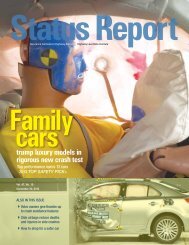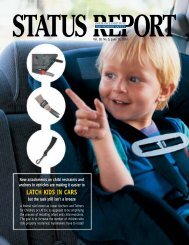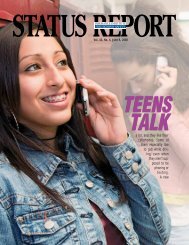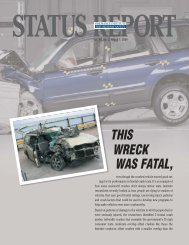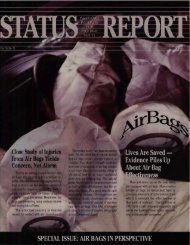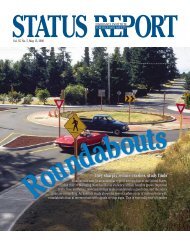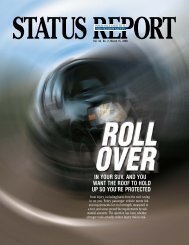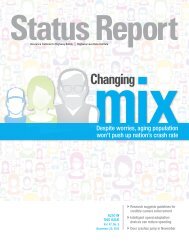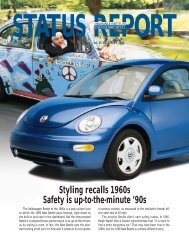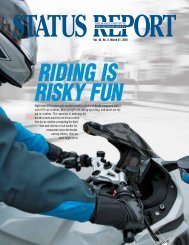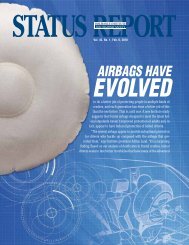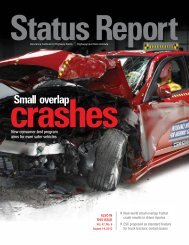Status Report, Vol. 47, No. 8 - Insurance Institute for Highway Safety
Status Report, Vol. 47, No. 8 - Insurance Institute for Highway Safety
Status Report, Vol. 47, No. 8 - Insurance Institute for Highway Safety
You also want an ePaper? Increase the reach of your titles
YUMPU automatically turns print PDFs into web optimized ePapers that Google loves.
<strong>Status</strong> <strong>Report</strong><strong>Insurance</strong> <strong>Institute</strong> <strong>for</strong> <strong>Highway</strong> <strong>Safety</strong> | <strong>Highway</strong> Loss Data <strong>Institute</strong>Boostersreach milestoneNearly all new seats provide good belt fitAlso Inthis issue<strong>Vol</strong>. <strong>47</strong>, <strong>No</strong>. 8October 25, 20124Speeds climbon freeways4Choosing speedover safety in Texas4Older teenagersbenefit from GDL
Fifteen of 17 booster seats introduced in 2012 earn the toprating of BEST BET from the <strong>Insurance</strong> <strong>Institute</strong> <strong>for</strong> <strong>Highway</strong><strong>Safety</strong>, evidence that more than ever, manufacturers are designingseats to provide good safety belt fit <strong>for</strong> booster-age children.The improvements mean that BEST BET boosters now outnumberseats in any of the three other categories <strong>for</strong> the first time since the<strong>Institute</strong> released its inaugural booster ratings in 2008 (see <strong>Status</strong><strong>Report</strong>, Oct. 1, 2008, at iihs.org). Boosters are supposed to improvehow adult lap and shoulder belts fit children so the belts can properlyrestrain them in crashes. BEST BET boosters correctly position beltson a typical 4-to-8-year-old child in almost any car, minivan or SUV.In all, there are <strong>47</strong> BEST BET boosters <strong>for</strong> 2012. This total includesthe latest models, plus older top-rated designs still on the market. Fiveseats are a GOOD BET, meaning they provide acceptable belt fit inmost vehicles. Two boosters are not recommended because they don’tprovide proper belt fit, and consumers are advised to avoid them.Federal regulations don’t address how a booster should positionsafety belts. Manufacturers crash test boosters, but these simulationsdon’t tell parents how boosters will fit their childrenin their vehicles. The <strong>Institute</strong> launched its ratings programafter research showed most boosters weren’t doing a goodjob of fitting safety belts correctly and consistently in avariety of vehicles.“Booster manufacturers have risen to the <strong>Institute</strong>’schallenge to improve seat design, giving parents morechoices than ever when shopping <strong>for</strong> a booster that willprovide a good, safe fit <strong>for</strong> their children,” says Anne Mc-Cartt, <strong>Institute</strong> senior vice president <strong>for</strong> research.Using a belt-positioning booster is important <strong>for</strong> kids whohave outgrown harness-equipped child restraints and aren’t bigenough <strong>for</strong> adult belts. Children ages 4-8 in boosters are 45 percentless likely to sustain injuries in crashes than kids restrainedby belts alone (see <strong>Status</strong> <strong>Report</strong>, Dec. 22, 2009). Children who areusing improperly fitted belts are at risk of a host of crash injuriesknown as “seat belt syndrome.” These include spine injuries and internalorgan injuries. Boosters help by elevating a child into positionand guiding the belts <strong>for</strong> better protection.<strong>No</strong> crash tests are conducted as part of the evaluations. The <strong>Institute</strong>’sratings focus on belt fit. They don’t assess how boosters mightper<strong>for</strong>m in a crash because safety belts do the main job of protectingchildren, not boosters. Some manufacturers say their boostersprovide enhanced protection in a side crash, but the <strong>Institute</strong> hasn’tevaluated these claims.To assess belt fit, <strong>Institute</strong> engineers use a test dummy representingan average-size 6-year-old child. They measure how lap andshoulder belts fit the dummy in each booster under four conditionsrepresenting the range of belt configurations in real-world vehicles.The <strong>Institute</strong> evaluates models new to the market each year. Ratingsof boosters with designs that carry over into the next modelyear remain on the list until the seats are discontinued. In all, thelatest ratings cover 91 boosters.Consumers have a variety of styles and a range of price points topick from. BEST BETs retail <strong>for</strong> as little as $19 to as much as $300.Among the new BEST BET models, the backless Graco TurboBoosterCOLORZ sells <strong>for</strong> about $26, the highback TurboBooster retails <strong>for</strong>about $50 and the backless Harmony Carpooler starts at about $35.2 |<strong>Status</strong> <strong>Report</strong> — <strong>Vol</strong>. <strong>47</strong>, <strong>No</strong>. 8
GracoTurboBoosterGraco TurboBooster<strong>Safety</strong> SurroundHarmony V6newnewnewnewnewnewnewnewnewnewHow boosterseats rateBEST BETBritax Frontier 85Harmony CarpoolerBritax Frontier 85 SICTnew Harmony Cruz Youth BoosterBritax Parkway SGL (highback mode) Harmony Dreamtime Booster(backless mode)BubbleBumHarmony Dreamtime BoosterChicco KeyFit Strada (highback mode)(highback mode)Clek Oobr (highback mode)Harmony OlympianCosco Pronto (highback mode)new Harmony V6 Highback BoosterDiono Monterey (highback mode)(backless mode)Diono RadianR100new Harmony V6 Highback Booster(highback mode)Diono RadianR120Diono RadianRXTHarmony Youth Booster SeatnewEddie Bauer Auto BoosterKiddy Cruiserfix Pro(highback mode)new Kiddy World PlusEvenflo Big Kid AmpKids Embrace Dale Earnhardt Jr.Evenflo Big Kid Amp High Back Maxi-Cosi Rodi XR (highback mode)(backless mode)Recaro ProBOOSTEREvenflo Big Kid Sport (backless mode) Recaro ProSPORTEvenflo MaestroRecaro VivoEvenflo Secure Kid LX/DLX<strong>Safety</strong> 1st Boost Air ProtectEvenflo Symphony 65 e3(highback mode)Ferrari Dreamway SP (highback mode) <strong>Safety</strong> 1st S1 Rumi Air/Essential AirGraco Argos 70 (highback mode) The First Years Pathway B570Graco Backless TurboBoosterGraco Nautilus (highback mode)GOOD BETGraco TurboBooster (backless mode)Britax Parkway SG (highback mode)Graco TurboBooster (highback mode)Combi Kobuk Air-Thru (backless mode)Graco TurboBooster COLORZCombi Kobuk Air-Thru (highback mode)Graco TurboBooster EliteEvenflo Symphony 65(backless mode)Maxi-Cosi Rodi (highback mode)Graco TurboBooster Elite(highback mode)Graco TurboBooster <strong>Safety</strong> Surround(backless mode)NOT RECOMMENDEDGraco TurboBooster <strong>Safety</strong> Surround<strong>Safety</strong> 1st All-in-One(highback mode)<strong>Safety</strong> 1st Alpha Omega EliteThree dual-use boosters new <strong>for</strong> 2012 earnBEST BET: Graco TurboBooster, Harmony V6 andGraco TurboBooster <strong>Safety</strong> Surround. They join theGraco TurboBooster Elite and Harmony Dreamtime astop-rated boosters that provide good belt fit when usedas highback or backless seats. Another dual-use model,the Combi Kobuk Air-Thru, is a GOOD BET.To access photos and model numbers ofevery booster evaluated go to iihs.org orm.iihs.org from your smartphone.October 25, 2012 |3
Cosco Top SideGraco TurboBooster COLORZTop-rated boosters don’t have to be pricey. The Graco TurboBooster COLORZ (right) is a BEST BET and retails <strong>for</strong> about $26. The COLORZ is a better choice thanthe Cosco Top Side (left), a new backless model that is a Check Fit because it doesn’t consistently provide good shoulder belt fit. The Top Side sells <strong>for</strong> about $15.CHECK FITBritax Parkway SG (backless mode)Britax Parkway SGL (backless mode)Chicco KeyFit Strada (backless mode)Clek OlliClek Oobr (backless mode)Clek OzziCosco AmbassadorCosco Highback BoosterCosco Pronto (backless mode)new Cosco Top SideDiono Monterey (backless mode)Diono SantaFeEddie Bauer Auto Booster(backless mode)new Evenflo Big Kid Amp High Back(highback mode)Evenflo Big Kid LX (backless mode)Evenflo Big Kid LX (highback mode)Evenflo Big Kid <strong>No</strong> Back BoosterEvenflo Big Kid Sport (highback mode)Ferrari Dreamway SP (backless mode)Ferrari OlaGraco Argos 70 (backless mode)Graco Nautilus (backless mode)Graco Nautilus Elite (backless mode)Graco Nautilus Elite (highback mode)Graco Smart SeatMaxi-Cosi Rodi (backless mode)Maxi-Cosi Rodi XR (backless mode)<strong>Safety</strong> 1st Boost Air Protect(backless mode)<strong>Safety</strong> 1st Go Hybrid<strong>Safety</strong> 1st Summit<strong>Safety</strong> 1st Vantage<strong>Safety</strong> 1st VenturaThe First Years Compass B505The First Years Compass B530The First Years Compass B540<strong>Vol</strong>vo Booster (backless mode)<strong>Vol</strong>vo Booster (highback mode)Dual-use boostersBoosters come in two main styles: highback andbackless. Highbacks have guides to route lap andshoulder belts and can offer some head support.Backless models have lap belt guides but mayneed a plastic clip to properly position shoulderbelts in many vehicles. Some highbacks, calleddual-use, can be converted to backless seats.These get two ratings, one <strong>for</strong> each mode, becausebelt fit can differ by mode. Consumers should payattention to each rating and consider how theywill use the seats in their vehicles.Six of the 24 dual-use boosters included in the2012 ratings earn BEST BET or GOOD BET inboth modes. These include two from HarmonyJuvenile Products, the Dreamtime and V6 HighbackBooster; one from Combi USA Inc., theKobuk Air-Thru; and three by Graco Children’sProducts Inc., the TurboBooster, TurboBoosterElite and TurboBooster <strong>Safety</strong> Surround.Graco now has 10 BEST BETs, and all eight ofthe boosters Harmony makes are BEST BETs.“Parents often tell us they want a dual-usebooster that’s a BEST BET no matter how theyuse it,” McCartt says. “Having more to pick fromreally simplifies things.”For its dual-use TurboBoosters, Graco revisedthe instruction manual and relocated the beltclip to the back center of the seat from the side.The change allows the clip to correctly positionthe shoulder belt, lifting the backless mode ratingfrom Check Fit, in line with the highback rating.Check Fit seatsThe 37 boosters in the Check Fit category may providegood fit <strong>for</strong> some children in some vehicles,but not as many as a BEST BET or GOOD BET. Aswith any booster, parents should make sure the lapbelt lies flat across their child’s upper thighs and theshoulder belt crosses snugly over the middle of theshoulder. If not, try a different seat.Two boosters in this group are new <strong>for</strong> 2012, theEvenflo Big Kid Amp High Back and the Cosco TopSide. The Big Kid Amp High Back is a BEST BETin backless mode, but parents will need to checkhow the belt fits if the seat is used as a highback.In some cases, the Big Kid Amp may positionthe lap belt too high on the abdomen in highbackmode. The seat is made by Evenflo CompanyInc. Evenflo discontinued four models thathad been not recommended last year (see <strong>Status</strong><strong>Report</strong>, Oct. 13, 2011). The company picks up twoadditional BEST BET designations, earning it sixBEST BETs and one GOOD BET <strong>for</strong> 2012.Shoulder belt fit is the issue with the Cosco TopSide. The owner’s manual atypically instructs installersto route the shoulder belt over the backlessbooster’s lap belt guide instead of under it.This puts the belt too far off the shoulder in onemeasurement condition and against the neck inanother. Some parents might be able to get goodshoulder belt fit with the booster, depending onAn engineer at the <strong>Institute</strong>’s Vehicle ResearchCenter evaluates how lap and shoulder belts fit atest dummy representing an average-size 6-year-oldchild under four conditions representing a range ofbelt configurations in real-world vehicles.4 |<strong>Status</strong> <strong>Report</strong> — <strong>Vol</strong>. <strong>47</strong>, <strong>No</strong>. 8
Combination seatslike this BritaxFrontier 85, a BESTBET in highbackmode, can be usedas a harnessequippedchildrestraint in additionto a booster.their vehicle setup and the age and size of their child. The Top Sideis made by Dorel Juvenile Group Inc., whose brands include Cosco,Eddie Bauer Baby, Maxi-Cosi and <strong>Safety</strong> 1st. Five of Dorel’s boostersare BEST BETs and one is a GOOD BET.3-in-1 boostersThe two not recommended boosters — both from Dorel — areolder designs first evaluated in 2009 (see <strong>Status</strong> <strong>Report</strong>, Dec. 22,2009). They are the <strong>Safety</strong> 1st All-in-One and <strong>Safety</strong> 1st AlphaOmega Elite. These models are 3-in-1s that can be used as rearfacingand <strong>for</strong>ward-facing child restraints with a built-in harness.They can be converted to boosters by removing the harness andusing lap and shoulder belts to restrain a child. Although these seatsshould work well as child restraints, they aren’t the best option <strong>for</strong>boosters because they leave the lap belt too high on the abdomenand the shoulder belt too far out on the shoulder.“Dorel should redesign the All-in-One and Alpha Omega Elite toimprove booster function,” McCartt says. “Parents who own theseseats should use them with the built-in harness as long as possible,up to Dorel’s recommended height and weight limits.”There are better options <strong>for</strong> consumers who prefer the versatilityof a 3-in-1. Four BEST BETs are 3-in-1s. These include the EvenfloSymphony 65 e3 and three models from Diono LLC — the RadianR100, RadianR120 and RadianRXT. Another choice is the EvenfloSymphony 65, which is a GOOD BET.McCartt points out that manufacturers sometimes use similarnames <strong>for</strong> different seats, or even the same names <strong>for</strong> new models, soconsumers should consult the <strong>Institute</strong>’s website at iihs.org <strong>for</strong> modelnumbers, manufacture dates and photos when they shop <strong>for</strong> a booster.She advises parents not to be in a hurry to switch to a booster.Kids should ride in harness-equipped child restraints in rear seatsas long as possible, up to the height and weight limits of the seats.Many typically accommodate children up to about 65 pounds —and some go higher. When children outgrow child restraints, theyshould use boosters until adult belts fit properly, usually when achild reaches 4 feet 9 inches and 80 pounds. nEvaluating belt fitBoosters elevate children and position safety belts so the belts will fitthem better. The lap belt should lie flat and on top of a child’s upperthighs (far left), not higher up on the abdomen (near left).The shoulder belt should fit across the middle of a child’s shoulder(bottom left). If it falls off the shoulder (bottom center), or rests on theneck (bottom right), a child might move the belt behind their back orunder an arm, where it would be out of position <strong>for</strong> proper protection.October 25, 2012 |5
Freeway speeds rise as moredrivers exceed posted limitsDrivers continue to exceed posted speed limits on all kinds of roads, but the problem hasworsened on freeways and expressways. That is the takeaway from a new national survey oftraffic speeds by the National <strong>Highway</strong> Traffic <strong>Safety</strong> Administration (NHTSA).The agency measured free-flow travel speeds during 2007 and 2009 <strong>for</strong> all types of motorvehicles on freeways, arterials and collector roads across the United States. On limitedaccesshighways, the percentage of vehicles exceeding posted speed limits by any amountjumped 23 percentage points from 2007 to 2009. Fourteen percent of all vehicles travelinglimited-access highways exceeded posted speed limits by 10 mph or more during 2007. Thepercentage rose to 20 percent during 2009. On other types of roads, proportions of driversexceeding the speed limits fell slightly in 2009 compared with 2007. Still, 13 percent ofvehicles on major arterials and 15 percent on minor arterials traveled at least 10 mph overposted speed limits during 2009.NHTSA cautions that the increase intravel speeds may be due to differences indata collection periods. Continued speeden<strong>for</strong>cementcampaigns in some states and a2009 decline in vehicle miles traveled amidthe U.S. recession may have had an effect, theagency says. Less-congested roads may haveprompted motorists to drive faster.The survey marks the first time NHTSAhas collected nationally representative estimatesof travel speeds on public roads <strong>for</strong>all types of motor vehicles. States used tosubmit speed data to the Federal <strong>Highway</strong>Administration, but that requirement wasabolished with the 1995 repeal of the nationalmaximum speed limit.“National travel speeds survey II: 2009”by R. Huey et al. is available at www.nhtsa.gov/staticfiles/nti/pdf/8116<strong>47</strong>.pdf. nViewpoint: Choosing speedover safety in TexasBy Adrian Lund<strong>Institute</strong> presidentImagine cruising down the highway at 85mph without getting so much as a raised eyebrow,let alone a ticket. For many drivers, itsounds like a dream, and it’s set to come trueon one Texas road. But we’ve seen this onebe<strong>for</strong>e, and it doesn’t end well.Decades of research show that when speedlimits are raised, drivers go faster and morepeople die in crashes. The Texas TransportationCommission’s decision to establish thehighest speed limit in the land on a new tollroad between Austin and San Antonio meansdrivers there will be able to get to their destinationsquickly, but at a cost.Percentage of vehicles exceedingspeed limit by mph over limit and yearPercentage of vehiclesRoad class 2007 2009 changeLimited accessBy any amount 48% 72% 23%By > 5 mph 28% 46% 17%By > 10 mph 14% 20% 6%Major arterialBy any amount 60% 56% -4%By > 5 mph 34% 31% -3%By > 10 mph 15% 13% -2%Minor arterial/collectorBy any amount 61% 59% -2%By > 5 mph 35% 33% -2%By > 10 mph 16% 15% -1%High speeds increase the likelihood of acrash while simultaneously slashing the oddsof surviving one. Crashes are more likely because,at a higher speed, a vehicle travels alonger distance in the split second it takes toreact to an emergency. And the faster the vehicleis going, the further it will travel be<strong>for</strong>ecoming to a stop after the driver slams on thebrakes. When crashes occur, they are deadlierat high speeds because the energy involvedincreases exponentially as speed rises.At the <strong>Insurance</strong> <strong>Institute</strong> <strong>for</strong> <strong>Highway</strong><strong>Safety</strong>, be<strong>for</strong>e we rate a vehicle <strong>for</strong> frontalcrashworthiness, we send it hurtling toward abarrier at 40 mph, resulting in a severe collision.Most new vehicles today do well in ourmoderate overlap frontal test, meaning peoplecould survive a similar real-world crash withoutserious injuries. But at high speeds, allbets are off. The vehicle’s structure won’t holdup, and airbags and safety belts won’t be ableto do their job. When a crash is imminent,a car traveling 65 mph has a much betterchance of getting down to a survivable speedbe<strong>for</strong>e impact than a car traveling 85 mph.We know that many drivers exceed postedlimits, but that doesn’t mean they don’t takethem into account. Drivers typically pick aspeed at which they think they won’t get aticket — often 5-10 mph over the limit. ManyTexas drivers are no doubt already used todriving 85 mph on roads with 75 or 80 mphlimits. They’ll read the 85 mph signs as licenseto go 90 or more.The 17 years since Congress did away withthe national 55 mph maximum speed limithave given us plenty of opportunities to seewhat happens when speed limits are raised.6 |<strong>Status</strong> <strong>Report</strong> — <strong>Vol</strong>. <strong>47</strong>, <strong>No</strong>. 8
Graduated licensing benefitsolder beginners in AustraliaAfter the speed limit on three urban freeways inTexas was raised from 55 to 70 in the mid-1990s,we found that half the vehicles were going fasterthan 70 within a year, compared with 15 percentbe<strong>for</strong>e. Seventeen percent were exceeding 75 mph,compared with 4 percent be<strong>for</strong>e the change.Around the country, such increases translated intomore deaths. In 24 states that raised speed limits wefound 15 percent more fatalities on interstates andfreeways than otherwise would have been expected.Even with today’s speed limits, speed-relatedcrashes cause more than 10,000 deaths a year —nearly a third of all crash fatalities in the country.States could prevent some of these deaths if, insteadof giving drivers permission to go ever faster,they vigorously en<strong>for</strong>ced existing limits to slowdrivers down.(This op-ed appeared in the Sept. 18, 2012, editionof the Atlanta Journal-Constitution.) nLicense restrictions are known to reduce crashes among 16-17-year-old drivers in theUnited States. <strong>No</strong>w a study of recent changes to graduated licensing in Victoria, Australia,shows they can be effective <strong>for</strong> newly licensed 18-20 year-olds, too.The study, commissioned by VicRoads, the state agency in charge of licensing, foundthat after the changes, injury crashes fell 23 percent <strong>for</strong> 18-20 year-olds in their firstyear of probationary driving when measured against a control group of 26-38-year-olddrivers. Fatal and serious injury crashes fell 31 percent.A would-be driver must be at least 16 years old to get a learner’s permit in Victoriaand at least 18 to obtain a probationary, or intermediate, license. In 2007 and 2008 therequirements and restrictions accompanying each stage were beefed up.The first set of changes, which went into effect in July 2007, required young drivers tohold their permits <strong>for</strong> a year and obtain 120 hours of supervised driving experience be<strong>for</strong>eapplying <strong>for</strong> a probationary license. Also at that time, probationary drivers were barredfrom driving high-powered vehicles such as those with eight-cylinder engines.Then, in July 2008, the probationary period was increased from three to four years.Additional restrictions were put in place <strong>for</strong> the first year of the probationary license,known as the P-1 phase. They included a ban on all cellphone use, including hands-free,and a limit of one passenger betweenthe ages of 16 to 21. Driverswere required to maintain agood driving record in order tograduate from P-1 to P-2, whichlasts the remaining three years.In addition, a new road test wasintroduced <strong>for</strong> obtaining a P-1license, with the aim of betterevaluating driving skills.In addition to the crash reductionsin the first year of probationarydriving, the report’sauthors found similar decreasesin the second year as a result of the changes, though not as large.Injury crashes fell 23 percentamong 18-20 year-olds intheir first year of probationarydriving in Victoria, Australia.Fatal and serious injurycrashes declined 31 percent.Young drivers also were surveyed about their behaviors as part of the evaluation.After the restrictions were strengthened, probationary drivers were less likely to saythey drove with more than one 16-21-year-old passenger and reported fewer traffic offensesand less cellphone use.Victoria’s graduated licensing system is in many ways stricter than anything in placein the United States. The current best practices here are a minimum permit age of16 (eight states and the District of Columbia), at least 65 supervised practice hours(Pennsylvania), a minimum intermediate license age of 17 (New Jersey), a night drivingrestriction starting at 8 p.m. during the intermediate stage (Idaho and South Carolina)and in 15 states and D.C., a ban on all teen passengers (see <strong>Status</strong> <strong>Report</strong>, May31, 2012, at iihs.org).Research by the <strong>Insurance</strong> <strong>Institute</strong> <strong>for</strong> <strong>Highway</strong> <strong>Safety</strong> and the <strong>Highway</strong> Loss Data<strong>Institute</strong> has shown that the stronger the graduated licensing provisions, the biggerthe reductions in crashes and fatal crashes (see <strong>Status</strong> <strong>Report</strong>, May 7, 2009). Althoughthe exact provisions of Victoria’s law aren’t identical to those familiar in the U.S., thisstudy shows that tougher rules can drive down teen crash rates even under a higherminimum licensing age.“Victoria’s graduated licensing system evaluation interim report” by D. Healy et al. isavailable at www.vicroads.vic.gov.au. nOctober 25, 2012 |7
<strong>Status</strong> <strong>Report</strong>Booster seat ratings42Drivers continue to speed46Texas chooses speed over safety46GDL works <strong>for</strong> older teens in Australia<strong>47</strong>The <strong>Insurance</strong> <strong>Institute</strong> <strong>for</strong> <strong>Highway</strong> <strong>Safety</strong> is an independent, nonprofit scientific and educational organization dedicatedto reducing the losses — deaths, injuries and property damage — from crashes on the nation’s roads.The <strong>Highway</strong> Loss Data <strong>Institute</strong> shares and supports this mission through scientific studies of insurance data representingthe human and economic losses resulting from the ownership and operation of different types of vehicles and by publishinginsurance loss results by vehicle make and model.Both organizations are wholly supported by the following auto insurers and funding associations:<strong>Vol</strong>. <strong>47</strong>, <strong>No</strong>. 8October 25, 20121005 N. Glebe RoadArlington, VA 22201 USAt 703/2<strong>47</strong>-1500f 703/2<strong>47</strong>-1588Inquiries/print subscriptions:<strong>Status</strong><strong>Report</strong>@iihs.orgCopy may be republished withattribution. Images requirepermission to use.Editor: Kim StewartWriter: Sarah KarushArt Director: Steve EwensTechnical Photographer: Matt Dalywww.iihs.orgiihs.org/rssyoutube.com/iihs@IIHS_autosafetym.iihs.orgThis publication is printed on recycled paper.Member groupsAcceptance <strong>Insurance</strong>ACE Private Risk ServicesAffirmative <strong>Insurance</strong>Agency <strong>Insurance</strong> Company of MarylandAlfa Alliance <strong>Insurance</strong> CorporationAlfa <strong>Insurance</strong>Allstate <strong>Insurance</strong> GroupAmerican Family Mutual <strong>Insurance</strong>American National Family of CompaniesAmeriprise Auto & HomeAmica Mutual <strong>Insurance</strong> CompanyARI <strong>Insurance</strong> CompaniesAuto Club EnterprisesAuto Club GroupBankers <strong>Insurance</strong> GroupBituminous <strong>Insurance</strong> CompaniesCali<strong>for</strong>nia Casualty GroupCali<strong>for</strong>nia State Auto GroupCapital <strong>Insurance</strong> GroupChubb & SonColorado Farm Bureau Mutual <strong>Insurance</strong> CompanyConcord Group <strong>Insurance</strong> CompaniesCotton States <strong>Insurance</strong>COUNTRY FinancialDallas National <strong>Insurance</strong> CompanyDirect General CorporationDiscovery <strong>Insurance</strong> CompanyDriver’s <strong>Insurance</strong> GroupErie <strong>Insurance</strong> GroupEsuranceFarm Bureau Financial ServicesFarm Bureau <strong>Insurance</strong> of MichiganFarm Bureau Mutual <strong>Insurance</strong> Company of IdahoFarmers <strong>Insurance</strong> Group of CompaniesFarmers Mutual Hail <strong>Insurance</strong> Company of IowaFarmers Mutual of NebraskaFireman’s Fund <strong>Insurance</strong> CompanyFlorida Farm Bureau <strong>Insurance</strong> CompaniesFrankenmuth <strong>Insurance</strong>Gainsco <strong>Insurance</strong>GEICO GroupGeorgia Farm Bureau Mutual <strong>Insurance</strong> CompanyGMAC Personal Lines <strong>Insurance</strong>Goodville Mutual Casualty CompanyGrange <strong>Insurance</strong>Hallmark <strong>Insurance</strong> CompanyHanover <strong>Insurance</strong> GroupThe Hart<strong>for</strong>dHaulers <strong>Insurance</strong> Company, Inc.Homeowners of America <strong>Insurance</strong> CompanyHorace Mann <strong>Insurance</strong> CompaniesICW GroupImperial Fire & Casualty <strong>Insurance</strong> CompanyIndiana Farmers Mutual <strong>Insurance</strong> CompanyInfinity Property & CasualtyKemper PreferredKentucky Farm Bureau <strong>Insurance</strong>Liberty Mutual <strong>Insurance</strong> CompanyLouisiana Farm Bureau Mutual <strong>Insurance</strong> CompanyMaryland Automobile <strong>Insurance</strong> FundMercury <strong>Insurance</strong> GroupMetLife Auto & HomeMiddleOakMississippi Farm Bureau Casualty <strong>Insurance</strong> CompanyMMG <strong>Insurance</strong>Mutual of Enumclaw <strong>Insurance</strong> CompanyNationwideNew Jersey Manufacturers <strong>Insurance</strong> GroupNLC <strong>Insurance</strong> Companies, Inc.<strong>No</strong>dak Mutual <strong>Insurance</strong> Company<strong>No</strong>rfolk & Dedham Group<strong>No</strong>rth Carolina Farm Bureau Mutual <strong>Insurance</strong> Company<strong>No</strong>rthern Neck <strong>Insurance</strong> CompanyOld American County Mutual Fire <strong>Insurance</strong>Old American Indemnity CompanyOregon Mutual <strong>Insurance</strong>Pekin <strong>Insurance</strong>PEMCO <strong>Insurance</strong>Plymouth Rock AssuranceProgressive CorporationThe Responsive Auto <strong>Insurance</strong> CompanyRockingham GroupSafeco <strong>Insurance</strong>Samsung Fire & Marine <strong>Insurance</strong> CompanySECURA <strong>Insurance</strong>Sentry <strong>Insurance</strong>Shelter <strong>Insurance</strong>Sompo Japan <strong>Insurance</strong> Company of AmericaSouth Carolina Farm Bureau Mutual <strong>Insurance</strong> CompanySouthern Farm Bureau Casualty <strong>Insurance</strong> CompanyState Auto <strong>Insurance</strong> CompaniesState FarmTennessee Farmers Mutual <strong>Insurance</strong> CompanyTexas Farm Bureau <strong>Insurance</strong> CompaniesTower Group CompaniesThe Travelers CompaniesUnited EducatorsUSAAUtica National <strong>Insurance</strong> GroupVirginia Farm Bureau Mutual <strong>Insurance</strong>West Bend Mutual <strong>Insurance</strong> CompanyYoung America <strong>Insurance</strong> CompanyZurich <strong>No</strong>rth AmericaFunding associationsAmerican <strong>Insurance</strong> AssociationNational Association of Mutual <strong>Insurance</strong> CompaniesProperty Casualty Insurers Association of America



